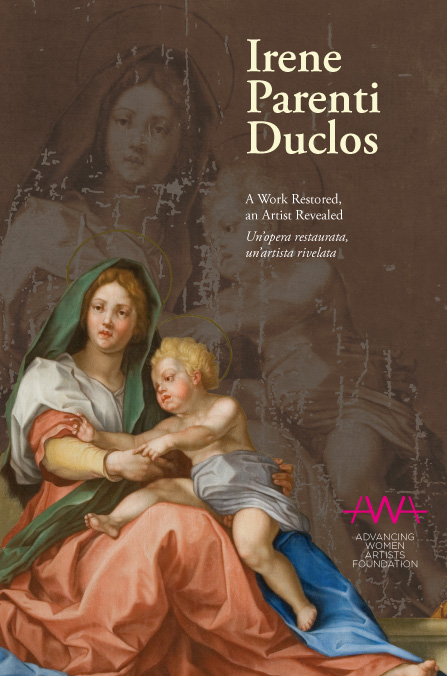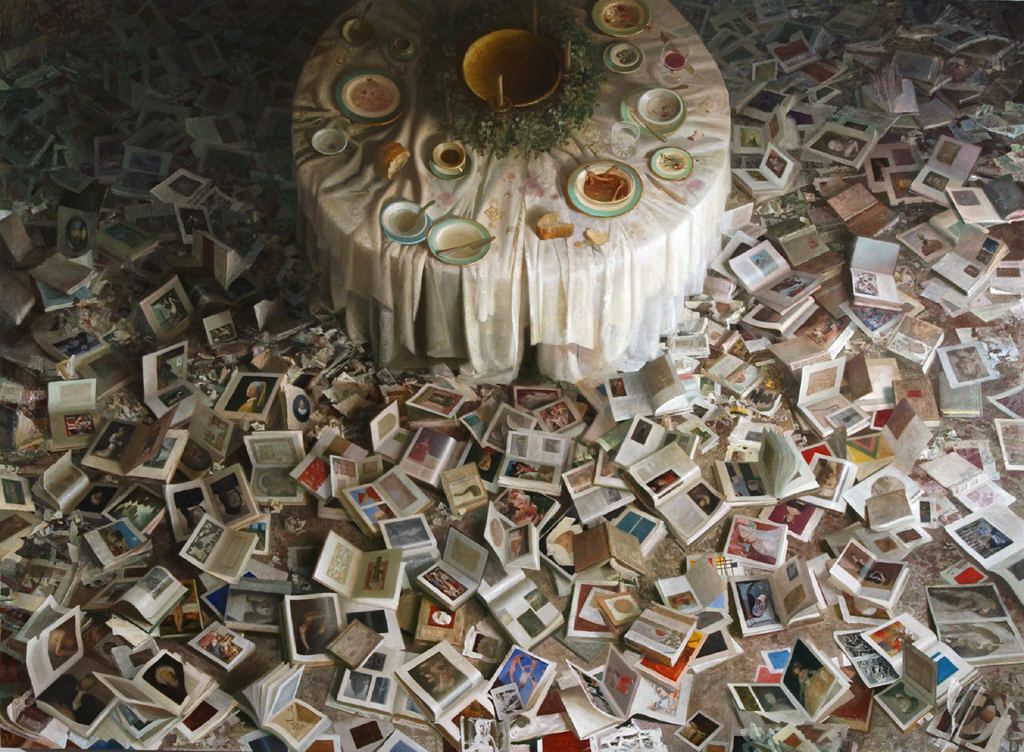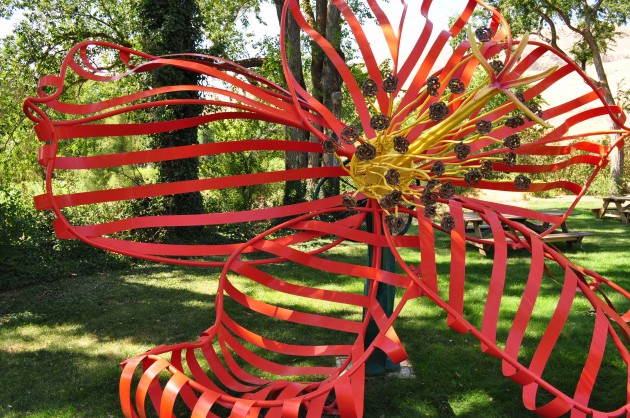Saturday, December 31st, 2011

Cover image of "Irene Parenti Duclos: A Work Restored, an Artist Revealed"
Congratulations to Val S., the winner of the Florentine Press giveaway, Irene Parenti Duclos: A Work Restored, an Artist Revealed! Val, if you could email me your mailing address information (see my email address in the sidebar), I can pass it along to the Florentine Press. Congratulations!
I hope that everyone has a wonderful 2012. I look forward to writing more posts (and learning more things!) in the upcoming year. This past year has been a fun and successful year for Alberti’s Window. Not only did I write sixty-seven posts this year, but I was able to move my content to this new site and design. Here are some links to my favorite AW posts from this past year:
It’s been fun for me to review my posts and look at the various things I discussed this year (although, admittedly, I wrote things with a slant toward Western/Renaissance/Baroque art). I love the diversity of my little blog, though. In some ways, my eclectic posts remind me of Vincent Desiderio’s Cockaigne (1993-2003, shown below). For ten years, Desiderio painted a canvas filled with open books. The book pages include miniature reproductions of his favorite masterpieces. The artists whose works are reproduced in Desiderio’s painting range from Masaccio to Vermeer to Picasso to Duchamp to Chuck Close. (If you want to learn more about this painting, I’d recommend that New York Times article, “A Ten-Year-Long Art History Course.”)

Vincent Desiderio, "Cockaigne," 1993-2003
I hope that in the upcoming year my humble little blog will offer an assortment of visual and scholarly pleasures, similar to Desiderio’s spread of paintings and books. Here’s to a great 2012! Happy art history-ing, too!
Friday, December 23rd, 2011

Evie Hone, detail of "Nativity," 1946. Stained glass window located at Saint Stanislaus College, Tullabeg
Keeping in line with the theme for this week on female artists (in connection with my ongoing GIVEAWAY!), I wanted to write a Christmas post on female artists who painted Nativity scenes. This was a much more frustrating project than I anticipated; it was difficult to come up with examples to share. I suppose I shouldn’t be surprised that there aren’t too many (extant) examples out there, but I am a little disappointed. In some ways, it seems a little ironic that the most famous artistic scenes about birth were created by men!
One of the examples that I enjoyed discovering was the Nativity window located at Saint Stanislaus College in Tullabeg, Ireland (see detail above). This window was created by the artist Evie Hone in the mid-20th century. Originally trained as a painter, Hone turned toward stained glass later in her career. S. B. Kennedy writes that this change to stained glass “gave [Hone] free rein to her growing power as a colorist.”1
There are a few contemporary nativity scenes which I think are interesting. Janet McKenzie was commissioned to create The Nativity Project. I think her painting Mary and the Midwives (2003) is quite interesting, not only in terms of style but also subject matter and composition. I also think Flor Larios’ Nativity Star (n.d.) is fun, as well as the Nativity scenes by Valerie Atkisson.
As for more historical art (pre-20th century), I have learned that most of the nativity paintings either longer exist (or are not available online). For example, a Nativity by Lucrina Fetti (17th century) was destroyed during the Napoleonic era.2 Similarly, I can’t find any location for the nativity scene that was made by Victorian artist Eleanor Vere Boyle (etched in brown ink on vellum).3 Another “untraced” painting was created by the discalced Carmelite nun, Maria Eufrasia della Croce painted a nativity scene for the church San Giuseppe a Capo al Case. The painting received quite a bit of praise. In the 17th century, Filippo de Rossi said that this painting was created by “a most excellent nun and painter of the place.”4 Even Bruzzio was able to drum up some praise for this painting, saying that “even if it is by a woman it is not a displeasing work.”5
It is disappointing that these works don’t exist anymore. However, don’t let this thought keep you from enjoying the Christmas holiday, friends! Do you know of any other nativity scenes (or “Adoration of the Shepherds” scenes) created by female artists? Please share! One of the only other examples (which is kinda-sorta similar to Christmas nativity scenes) is Artemisia Gentileschi’s Birth of Saint John the Baptist (c. 1635).
Happy holidays!
Monday, September 19th, 2011

Matt Cartwright, "Malabar Bombax," 2009
Friends! Readers! Bloggers! Welcome to the new website and design for Alberti’s Window! My husband J designed and programmed this site for me as a Christmas present, but it has taken nine months to get things underway. I’m thrilled to have a more visually-appealing location to discuss things that are visually appealing.
I thought I’d share with you a quote that I read a few weeks ago, when visiting the sculpture garden of the Maryhill Museum of Art (a simply delightful “collection museum” that was listed in a post from earlier this summer). Artist Matt Cartwright wrote this for the text label of his sculpture, Malabar Bombax (shown above): “This flower of the Red Silk Cotton tree – with its blooming shape – is a colorful, luscious inspiration to me. . . And perhaps this sculpture can evoke the viewer’s inner insect as they buzz from sculpture to sculpture within the Maryhill Sculpture Garden.”
I love the comparison between an insect and someone visiting a sculpture garden (or even a museum, for that matter). Like Cartwright, I’m hoping that I can evoke your “inner insect” with this new visual emphasis at Alberti’s Window. Feel free to flit from post to post, enjoying the larger images and clean design. Please update your RSS feeds and links to this new website. And while you are at it, could you please do a little pollination and share this new website with others?
Thursday, April 28th, 2011
Today one of my students was telling me about a comparatively recent exhibition by brothers Jake and Dinos Chapman. Titled If Hitler Had Been a Hippy How Happy Would We Be, the exhibition ran at the White Cube gallery during May 2008. In preparation for this show, the Chapman brothers bought several watercolors by Hitler. Then, the two brothers painted the backgrounds of Hitler’s watercolors with rainbows, smiley faces, floating hearts, and psychedelic skies.
This idea of appropriating the work of another artist is nothing new to the contemporary art scene. When hearing about this exhibition by the Chapman brothers, I was immediately reminded of John Fekner’s X Americana X series (1985), in which Fekner painted over “found” kitsch paintings.

But this exhibition by the Chapmans is different than Fekner’s series. Why? Well, because it’s Hitler’s art. The Chapman brothers insist that they are not trying to profit from Hitler’s notoriety with their exhibition, but simply try to explore Hitler’s psychology. Personally, I think that first claim is ridiculous. Of course these artists are trying to get attention and profit because of the connection with Hitler – there’s no way around that fact. If they were purely interested in the “psychology of the artist,” I think they could have explored that idea without publicizing Hitler’s name. Granted, Hitler does need recognition for his contribution to the show. And yes, the psychological connection with Hitler is terribly interesting. But one can consider the “psychology of the artist” with pure visual elements, without knowing who created the work of art.
As you can imagine, this exhibition caused quite a bit of controversy. Some find Chapman’s work to be unethical and unrespectful, while others feel like Hitler’s art deserves to be defaced. You can get a sense of some previous discussions on the topic here.
Personally, I don’t have a problem with these paintings being “tweaked” by the Chapman brothers. (But I know this reaction is because I’m not that excited about Hitler’s artwork in the first place.) I would have been bothered if Chapmans additions had defaced the bulk of Hitler’s compositions and figures, but that doesn’t seem to be the case. The work of the original artist is still there, but the context and meaning has changed.
What do others think?
Tuesday, May 25th, 2010
I’ve been thinking about Alexander Brener lately. You may have heard of him: he’s the Russian performance artist who in 1997 painted a green dollar sign over Malevich’s Suprematism (White Cross) (see left). Brener claimed that his gesture was protesting the role of money in the art world. The media coverage focused on the monetary damage done to the painting (which was valued at €6 million), which Brener said exactly proved his point.1
Other artists have also decided to destroy or manipulate another work of art in order to make an artistic statement or protest. If you’re interested in seeing some examples, I would recommend that you read this fascinating post. The author mentions several examples of art destruction (including the story of Mark Bridger, who spilled black ink into one of Damien Hirst’s formaldehyde tanks). I learned from this post that a couple of artists have urinated on/in Duchamp’s Fountain at different times in the past two decades. Ha! I think that idea might have been clever the first time, but the repeated attempts seems a little silly.
Obviously, such destructive artistic statements go against the ethics and standards for societal conduct. But this has got me thinking: should art be ethical? I can’t bring myself to completely say yes or no. But I don’t think it’s right to encourage unethical or criminal behavior among artists. (Or do such artists think that they are exempt from the societal rules and constraints? If so, then someone should break the news that postmodernism doesn’t embrace the “artist as genius” mentality.)
But, all that being said, I do have to admit one thing: such destruction can make me think about a work of art from a new perspective. And that’s one of the things that I like most about art.
What do you think? Should art be ethical?
1 Don Thompson, The $12 Million Stuffed Shark: The Curious Economics of Contemporary Art (London: Palgrave Macmillan, 2008), 184.






